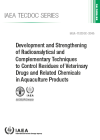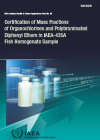Ensuring food safety and quality is a central public health concern. Food can be contaminated by toxic metals, pesticides and veterinary drug residues, as well as organic pollutants, radionuclides and mycotoxins. Radiometric and related techniques, tailored to local needs, are used in supporting national programmes to control such contaminants.
Residues and contaminants in food
Contamination hazards in the agricultural food chain can stem from a range of sources, including residues of agrochemicals and natural toxins. Aside from important public health considerations, the economic impact of food contamination can be significant and might adversely affect international trade.
Nuclear techniques can help detect, monitor and track contaminants in foods. Together with the FAO, the IAEA supports and encourages Member States to use radiometric and related analytical tools to monitor and control veterinary drugs, pesticides and mycotoxins in foods. Working with other international organizations, we help set the necessary standards for contamination levels of radionuclides, toxic metals and other organic pollutants. We also support the adoption of Maximum Residue Limits (MRLs) recommended by the Codex Alimentarius Commission, a body established by the FAO and the World Health Organization in 1963 to develop harmonised international food standards.
Food contaminants and the use of nuclear techniques
- Microbiological contamination of food by pathogens, such as Salmonella or E. coli, has significantly increased over the past decades. Strengthen food safety in this area requires a holistic approach in testing chemical and other natural contaminants and microbial hazards in the same foods, since the detection of a pathogenic food hazard in end-products implies a failed process.
- Pesticides and other agrochemicals are essential tools for farmers to reduce crop losses and increase yields, but must be regulated and used correctly to avoid endangering human health and the environment. Analytical laboratories are critical in pesticide residue monitoring and education on the safe and effective use of pesticides. Most developed countries have established MRLs for pesticide residues in foods.
- Residues of veterinary drugs, used to control animal diseases and improve production, may pose health risks. They must be controlled through national monitoring programmes guided by competent laboratories to assure local and international consumers. Tools, such as radio-receptor and -immunoassays, stable isotope-labelled veterinary drugs and complementing chromatography methods, enable Member States to better support the monitoring of veterinary drug residues and related contaminants in food and environmental samples.
- Mycotoxins, the secondary metabolites of several fungi, contaminate many crop and animal foodstuff and feeds, posing health risks to consumers. They also affect animal health and productivity, and are therefore a threat to food safety and quality. They must be closely monitored and controlled. Competent testing laboratories help increase Member States’ proficiency in applying radiometric and related analytical techniques to control these toxins.
- Radionuclides, naturally occurring or anthropogenic, should be as low as reasonably achievable in food and the environment. Member States therefore need to have laboratories that are able to accurately determine natural radiation background levels.
- Metals and other organic pollutants are potentially toxic to humans, animals and the environment. Many countries, as well as the Codex Alimentarius Commission, have set maximum limits or codes of practice to protect human and environmental health. Proficient testing laboratories are essential to ensure the competent analysis and routine monitoring of these contaminants.









